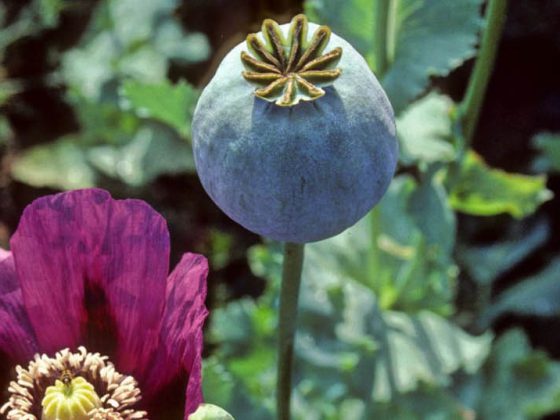Even the ingestion of small amounts of sesame seeds or sesame oil can lead to anaphylactic symptoms, as shown by the case studies in this article. Even as a non-atopic, one can develop monovalent sensitization to sesame.
Medical history
The 23-year-old student (C. Francesca) bought a falafel burger at the takeaway snack bar in the University Quarter. Within minutes of eating, she experienced a burning sensation in her mouth and lip swelling, followed by dyspnea, dysphagia, generalized urticaria, Quincke’s edema of the face, nausea, diarrhea, and chills, resulting in emergency admission to the emergency department of the University Hospital Zurich (USZ). There she was registered for allergological clarification at the allergy ward of the USZ.
Allergological clarification
At the initial consultation, the results of both routine prick testing with inhalant and food allergens and the spice series were negative, as were scratch tests with the native spices available at the allergy clinic. The patient was instructed to get a falafel burger with all the ingredients from the same take away store.
Prick-to-prick testing conducted on another day with the falafel burger and with the other components of the snack brought in were negative except for a strong reaction to the “white sauce” (Fig. 1). According to the owner of the snack bar, it is a tahini sauce made from a sesame paste (finely ground sesame seeds) mixed with lemon juice, garlic, pepper and parsley. A scratch test performed later with sesame seeds was strongly positive (Fig. 2) and an IgE determination showed a positive result of RAST class 3 (8.5 kU/l) to sesame.
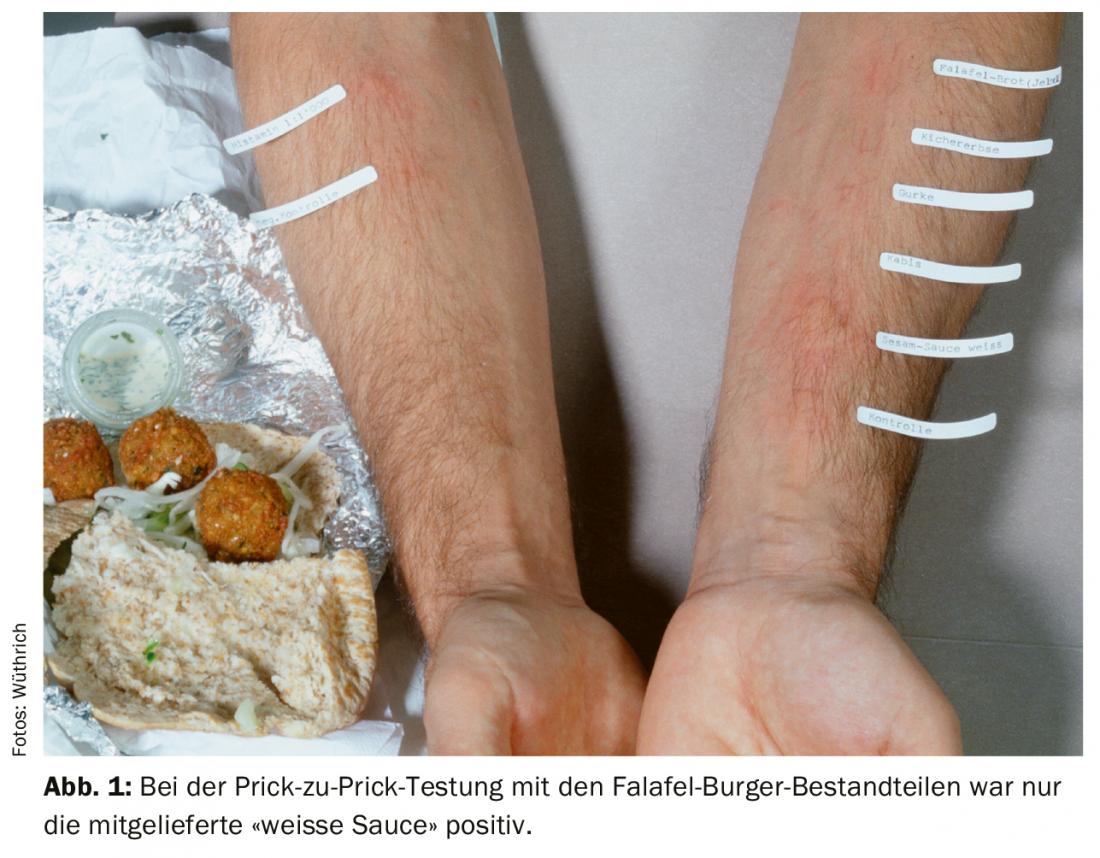
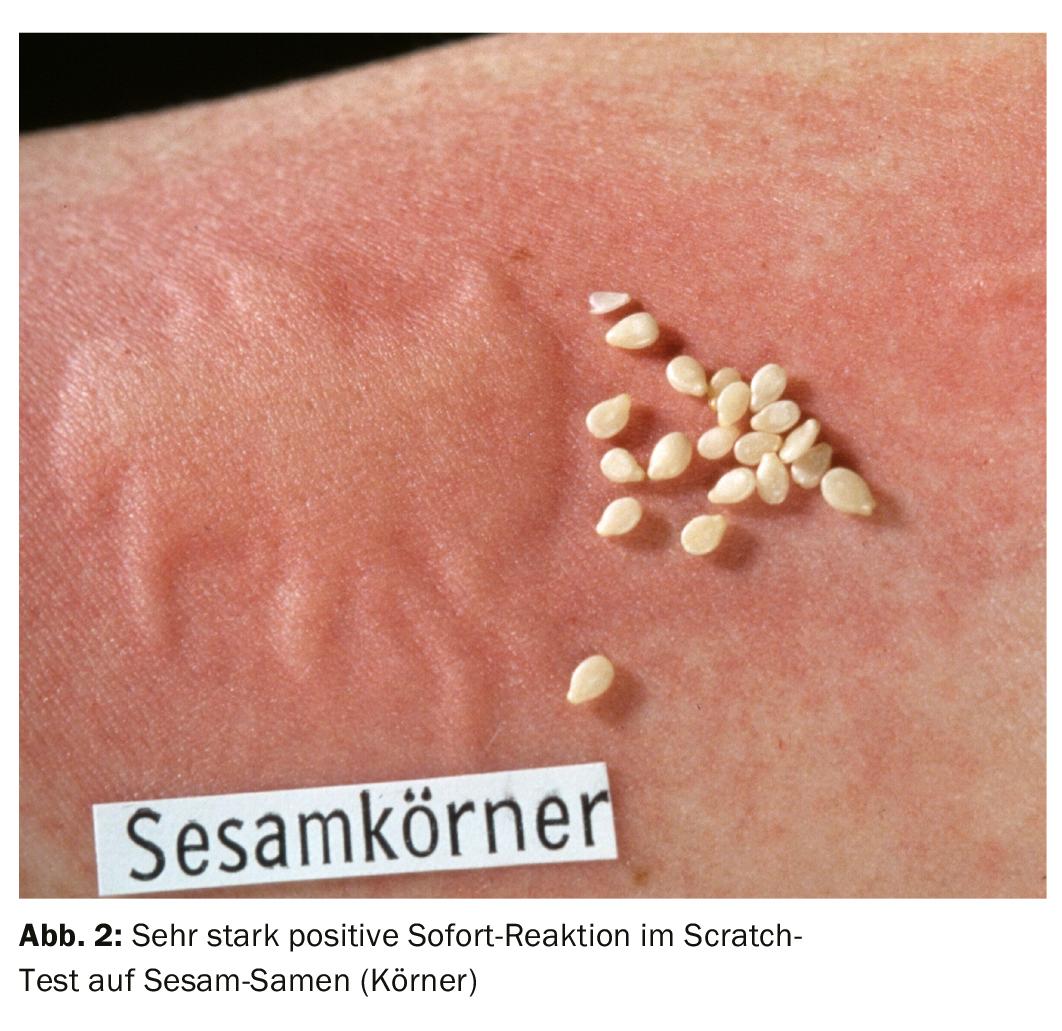
Subsequent anamnesis
The patient reported that she often suffered from sneezing attacks, runny nose, watery eyes, itching in the ears, and burning sensation on the skin in the décolleté area while cooking or preparing meals. She suspected an allergy to the spice mix used (Gourmet Mix Grill) (Fig. 3), which she subsequently avoided. According to the declaration, this spice mix contains garlic, bell pepper, salt, lemon zest, curry, coriander, mace, blue poppy, allspice, onion, paprika, orange peel, rosemary, thyme, nutmeg, ginger, chives, parsley, dill, tomatoes, sesame seeds, sprinkling spices, glutamate and maltrin. Apparently, the non-atopic patient (no personal or family history of hay fever, asthma, or atopic dermatitis; no positive prick test reactions to ubiquitous pneumo- and food allergens) became sensitized to sesame by inhalation.
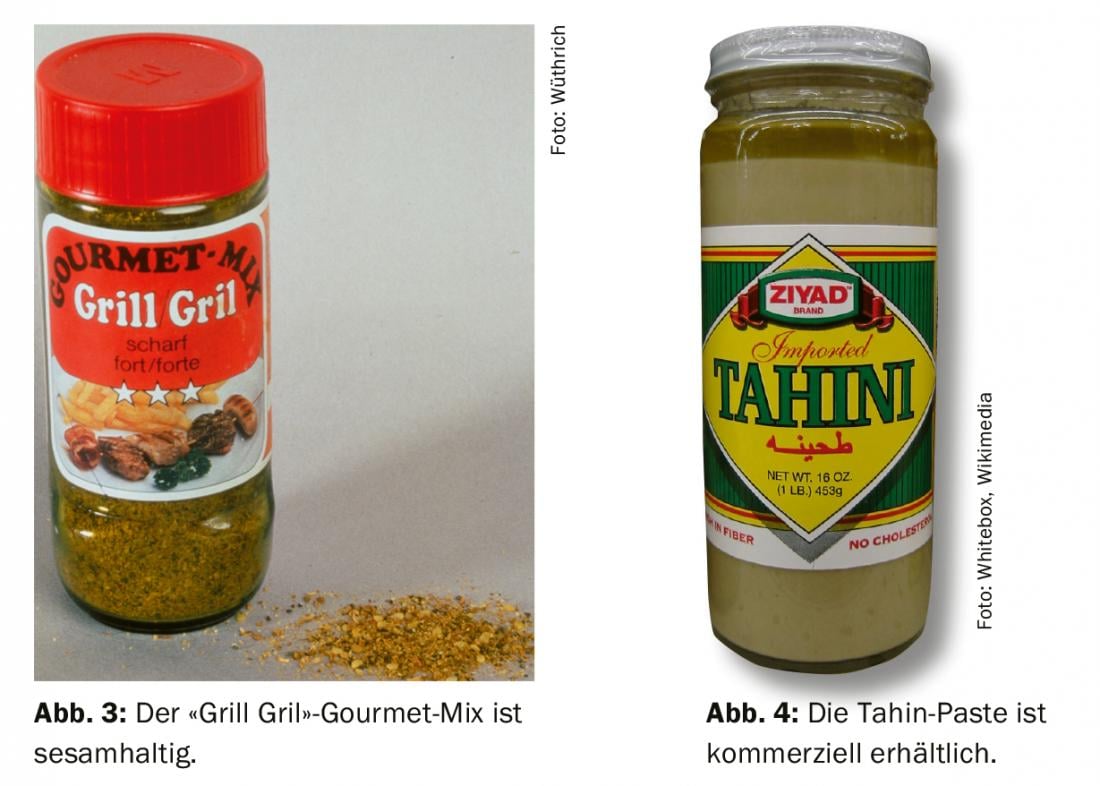
Diagnosis
- Falafel burger anaphylaxis in monovalent sensitization to sesame seeds.
Comment
The diagnostic designation “falafel burger anaphylaxis” [1,2] chosen when describing the case with my colleague Martin Kägi at that time is actually misleading, since the cause of the allergic reaction was not due to an allergen component in the falafel, but to one in the white sauce provided. It should therefore read “Tahini anaphylaxis after consumption of a falafel burger in monovalent sensitization to sesame”.
Falafel and tahini, oriental specialties
Falafel, according to Wikipedia [3], are deep-fried balls made from pureed chickpeas or beans and herbs and spices that are popular primarily as a snack. The dish originates from the Arabic cuisine. The place and time of the court’s origin are not known, but it is likely to be a very ancient court. Some historians assume it originated in Egypt, where it is also called ta’amia, and may have been created by the Christian Copts as a meatless dish for Lent. Others, however, suspect his origin rather in Lebanon or Palestine. Falafel is part of all the cuisines of the Middle East and parts of North Africa. In Israel, falafel is also considered a national dish and is prepared by all residents of Israel, regardless of ethnicity, origin or religion. In the Sephardic-Arabic-Jewish culture of the Middle East, falafel had a firm place as part of the local cooking tradition long before the establishment of the State of Israel. Falafel has also been offered in Germany and Switzerland since the early 1980s, mostly at Arabic-oriented snack stands, but increasingly also at Turkish ones as an alternative to kebab.
To prepare, first soak chickpeas or beans and put through a meat grinder. Then parsley, coriander herb, garlic and spring onions are finely chopped and added, as well as some baking powder and as spices salt, pepper and cumin. Depending on the recipe, dill, cayenne pepper or bulgur can be added. Then, all the ingredients are once again put through a meat grinder and kneaded into a dough [3]. After a resting time, the dough is formed into balls about the size of a walnut and deep-fried until golden brown.
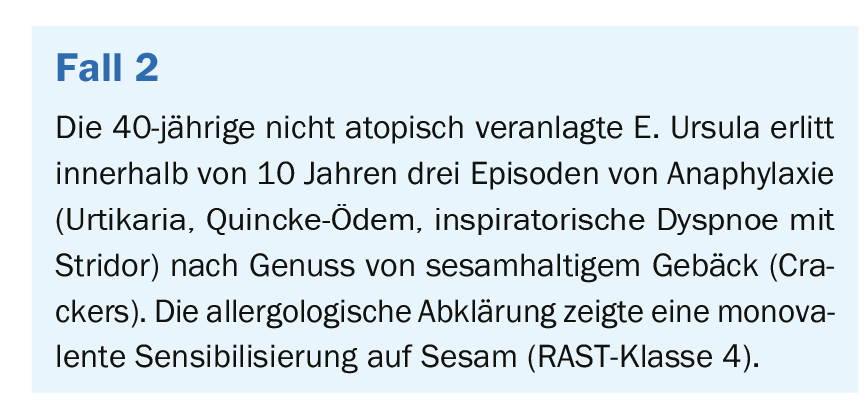
Thus, falafel also contains potential allergens, especially chickpea (Cicer arietinum): it is a plant species from the butterfly family (Faboideae ) subfamily within the legume family ( Fabaceae ) [4]. In case of allergy to the storage proteins (Ara h 2, 6, 7) of peanut, there is a cross-reaction to the storage protein of chickpea (Cic a 2S, a 2 S albumin) [5], so that allergic reactions to other legumes, such as the soybean, lentils, peas, and chickpeas, may also occur in peanut allergy.
Tahini, also tahina or tahini, is a paste made from finely ground sesame seeds [6]. Tahini comes from Arabic cuisine and is a basic ingredient of hummus (chickpea porridge) . It is also popular as a side dish or dip, mixed with lemon juice and garlic, often lightly decorated with spice sumac (a plant species of the genus sumac (Rhus 9). A distinction is made between tahini made from hulled and unhulled sesame seeds. Tahini made from unhulled sesame seeds is darker in color but contains more vitamins, nutrients and, at around 10 g per 100 g, more fiber. Often tahini is made from a mixture of both sesame seeds. Tahin made exclusively from hulled sesame seeds is called white tahina and can be bought commercially ready prepared (Fig. 4) . Tahin is very rich in vitamins (especially B1, B2 and B6) and contains a lot of calcium and iron. It is therefore very popular among vegetarians and vegans and is often offered as an alternative to spreads such as peanut butter in health food stores, but also in Turkish or Arab grocery stores. Also common in the Orient is baba ghanoush, a dip made from grilled, pureed eggplant and tahini. Tahini can also be used for the preparation of halvah. Although the ingredients used to make halvah vary to some extent from region to region, the basic mixture is generally a paste of oil seeds and sugar or honey. Halvah is refined or flavored by adding vanilla, cocoa, nuts, almonds, pistachios or sesame paste [7].
Sesame (Sesamum indicum)
Sesame is an East Indian plant of the Pedaliaceae family. The main areas of sesame cultivation are the Near East of India, China, Turkey, Egypt and in tropical East Africa [8]. Not only in these regions, but also in Central Europe and in North America your seeds are increasingly used – among other things because of its content of proteins rich in methionine [9].
Sesame seeds are found in bread, rolls, cookies, crackers, chips, cakes, apéritif pastries, oriental foods (halvah, Turkish honey, tahini, hummus, spice mixes, salad dressings and “whole foods”). It is widely used especially in infant food. Cold pressed sesame oil provides a high quality edible oil and can be included in margarine, but also in cosmetics and local therapeutics. Sesame oil, unlike other oils, contains reactive allergens because it is often enjoyed in unrefined or low-refined form.
Allergic reactions to sesame
With the increasing and often undeclared use of sesame, especially in a wide variety of Asian and Oriental dishes, an increase in allergic reactions to sesame can be expected in the future [10]. In Australia, sesame allergy is now more common than peanut allergy. In Israel, it ranks third among food allergies in children under two years of age, after hen’s egg and cow’s milk [9]. Allergic reactions to sesame oil are also known [11].
The boxes briefly describe some cases of sesame allergy observed by me at the allergy ward (USZ).
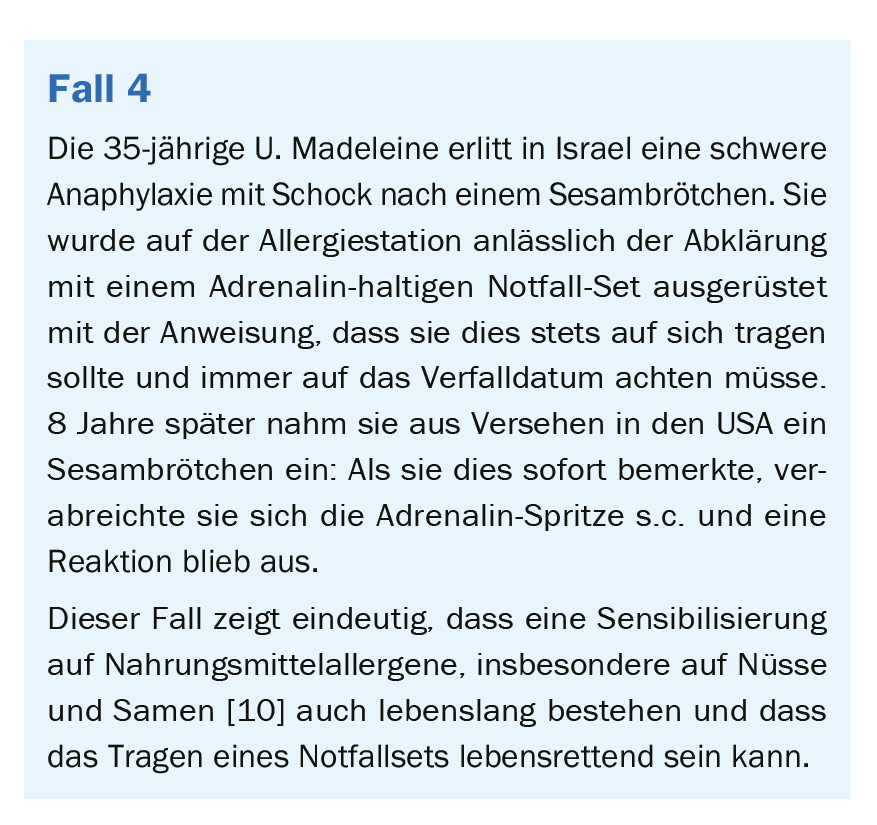
Molecular characterization of sesame allergens.
The responsible allergens are also found here mainly among the storage proteins. To date, 6 allergens have been characterized [9]:
- Ses i 1, a 2S-alumin of 9 kDa with relationship to 2S-albumins of sunflower seed, Brazil nut, castor bean (a major allergen usually without clinical relevance).
- Ses i 2, a 2S albulin of 7 kDa (probably a cleavage product of a 14 kDa 2S albumin – this is also a major allergen).
- Ses i 3 is a 7S vicilin-like globulin of 45 kDa (consists of a single polypeptide chain and is also a major allergen)
- Ses i 4 is an oleosin with 17 kDa
- Ses i 5 is an oleosin with 15 kDa (oleosins are remarkable in that – without changes – they pass into the oil – usually no IgE antibodies against these structures are detectable by usual methods (CAP, skin test). This could be due to the fact that they are insoluble and/or the IgE epitopes remain hidden, as in a case we described [12]. However, they become detectable in, for example, sodium dodecyl sulfate polyacrylamide gel electrophoresis (SDS-PAGE) [13]. Basophil activation test is also a valuable diagnostic method in case of negative IgE or skin test for sesame [14]. This should be taken into account when detecting the presence of sesame seeds).
- Ses i 6, an 11S globulin of 52 kDa (accounts for 60-70% of protein content and consists of an acidic (30-40 kDa) and basic (20-25 kDa) subunit linked by disulfide bridges).
Conclusions
“With sesame the gods season” is written on a clay tablet in cuneiform writing around 2000 J.J.B.Chr. But instead of an indulgence, ingestion, even just traces, of sesame seeds or sesame oil can cause severe anaphylaxis. Due to the increased occurrence of anaphylactic reactions to sesame, the European Union has included sesame in the list of food allergens requiring labeling [15], and in Switzerland since 2004 even in a more stringent form [16,17]. In the case of allergies to sesame, particular importance must be attached to patient education in the aftermath of an allergic reaction. On the one hand, it serves to prevent new allergen exposures, and on the other hand, it should contain information on self-management in case of recurrent reactions [15]. Cases of “food-dependent, exercise-inducecd anaphylaxis” have also been described with sesame, as with wheat and lupins [18,19] [20] .
Literature:
- Kägi M, Wüthrich B: Falafel-burger anaphylaxis due to sesame seed allergy. Lancet 1991; 338(8766): 582.
- Kägi M, Wüthrich B: Falafel burger anaphylaxis due to sesame seed allergy. Ann Allergy 1993; 71: 127-129.
- Wikipedia. The free encyclopedia: Falafel. https://de.wikipedia.org/wiki/Falafel, last accessed 11 March 2019.
- Wikipedia. The free encyclopedia: Chickpea. https:/en.wikipedia.org/wiki/chickpea, last accessed March 11, 2019.
- Hed J: Molecular allergy diagnostics. Cross-reactivity in allergies to plant foods. ThermoFisher. Phadia AB 2008, Uppsala, Sweden.
- Wikipedia: The free encyclopedia: Tahina. https://de.wikipedia.org/wiki/Tahina, last accessed 11 March 2019.
- Wikipedia: The Free Encyclopedia: Halva. https://de.wikipedia.org/wiki/Halva, last accessed 11 March 2019.
- Franke W: Nutzpflanzenkunde – Nutzbare Gewächse der gemässigten Breiten, Subtropen und Tropen 1997, 6th ed. Stuttgart: Thieme Verlag 1997.
- Jäger J, Vieths S: Food allergens. 8.11.2 Sesame (Sesanum indicum). In: Jäger L, Wüthrich B, Ballmer-Weber B, Vieths S (eds). Food allergies and intolerances. Immunology – Diagnostics – Therapy – Prophylaxis. 3rd ed. Elsevier GmbH, Munich: Urban & Fischer 2008. 184-185.
- Senti G, Ballmer-Weber BK, Wüthrich B: Nuts, seeds and kernels from an allergological point of view. Schweiz Med Wochenschr 2000; 130: 1795-1804.
- Chiu JT, Haydik IB: Sesame seed oil anaphylaxis. J Allergy Clin Immunol 1991; 88: 414-415.
- Stern A, Wüthrich B: Non-IgE-mediated anaphylaxis to sesame. Allergy 1998; 53: 325-326. First published: 29 April 2007. https://doi.org/10.1111/j.1398-9995.1998.tb03897.x
- Leduc V, et al: Identification of oleosins as major allergens in sesame seed allergic patients. Allergy 2006; 61: 349-356.
- Raap U, et al: The basophil activation test is a helpful diagnostic tool in anaphylaxis to sesame with false-negative specific IgE and negative skin test. Allergy 2011; 66: 1497-1499.
- Mühlenbein S, Pfützner W: Allergies to sesame: clinical significance, diagnosis and therapy. Allergo J 2018; 27: 46-57. https://doi.org/10.1007/s15007-018-1567-1
- Wüthrich B: The new food law in Switzerland. Allergology 2002; 25: 408.
- Wüthrich B: The new Swiss Food Ordinance (LMV). Allergology 2004; 27: 431-432.
- Wüthrich B: What is your diagnosis? Food-induced exertion-induced anaphylaxis in cases of severe sensitization to cereal proteins, especially rTri α19-omega-5-gliadin. DERMATOLOGIE PRAXIS 2013 (1); 25, 32-33.
- Wüthrich B, Mittag D, Ballmer-Weber BK: Pizza: a source of unexpected allergens – anaphylactic reaction to lupin flour in pizza dough and in a gingerbread. Allergology 2004; 27: 495-502.
- Gravett CM, Motala C: Food-dependent exercise-induced anaphylaxis associated with sesame seed ingestion – a case report. Curr Allergy Clin Immunol 2007; 20: 216-217.
DERMATOLOGIE PRAXIS 2019; 29(2): 7-10




